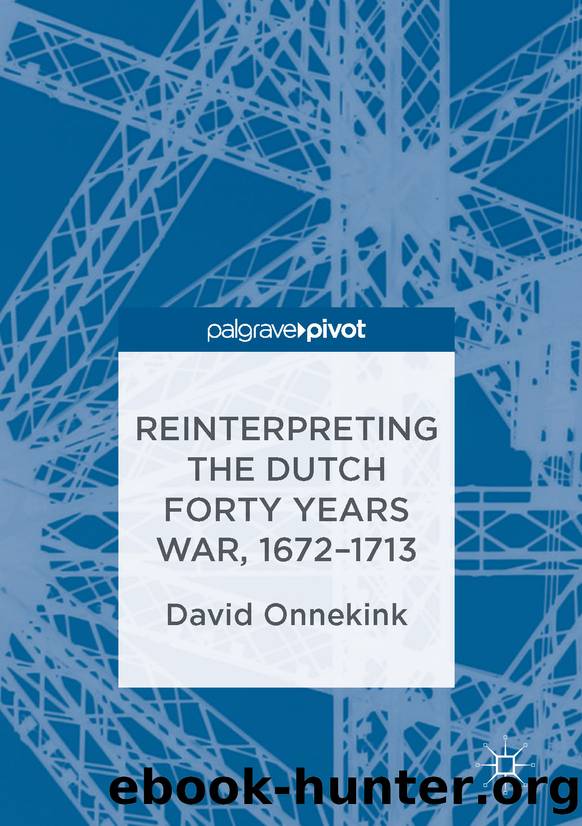Reinterpreting the Dutch Forty Years War, 1672â1713 by David Onnekink

Author:David Onnekink
Language: eng
Format: epub
Publisher: Palgrave Macmillan UK, London
Foreign Policy Discourses in Formal Published Documents
The autumn of 1688 saw an official trialogue between England, France and the Dutch Republic, reflecting on the complex international relations, mediated through government publications of diplomatic letters and resolutions. The focus was primarily on England and Cologne, rather than the Palatinate. On 9 September 1688, the French ambassador DâAvaux handed over a memorial to the States General, warning them to refrain from interference in English domestic affairs. He suggested that Louis would take it very ill should the Dutch take any hostile actions towards England; âthe bonds of friendship and the alliance he has with the King of Great Britain, wouldâ¦oblige him to come to his rescueâ. Moreover, an invasion of England would be regarded as an âopen ruptureâ with France and a âmanifest breach of peaceâ.10 This memorial was of monumental importance because DâAvaux constructed Louis and James as close allies, raising the spectre of repetition of 1672. DâAvaux also presented a second memorial that same day, in which he threatened the Dutch against intervening in Cologne. Louis vouched that he would âmaintainâ Fürstenberg âagainst all who would trouble himâ.11
The official publications are set in the context of frantic diplomatic negotiations that autumn, in which both England and France presented the Dutch Republic as warmongering. The French minister Croissy told the Dutch ambassador in Paris, Willem van Wassenaar-Sterrenburg âthat the armament of the State, both at sea as on land, alarmed all their neighboursâ and that the Dutch must have âa design on England or on France. That they wanted to start the most cruel and unjust war against the King of England that was ever heard ofâ. Wassenaar dismissed Croissyâs arguments. It was not the States General that alarmed their neighbours but the King of France âwho came down the Rhine with his army, and had so many troops along the frontiers of the state, which occupied the bishopric of Cologneâ. Was it any wonder, Wassenaar asked, that the Dutch prepared to defend themselves, âin order not to find themselves in the same predicament as in the year 1672, which was still fresh in their memory?â12
The English ambassador in The Hague, Ignatius DâAlbeville, as well feared a Dutch intervention. However, he believed the threat of the French 9 September memorial was counterproductive. There was no actual alliance between England and France, and the mere suggestion could cause an uproar in Parliament. DâAlbeville vehemently countered the notion of an Anglo-French understanding and condemned the threats Louis had made towards the Dutch.13 On 14 September the States General declared to DâAlbeville that they had no intention of waging war on âthe king and his peopleâ.14 On 16 October, the States General acknowledged that they were now convinced there was, after all, no alliance between France and England.15
However, in the official documents that followed that autumn, it was precisely this construction of the conjunction of the Kings of England and France bent on destroying the Dutch liberties and religion that dominated public discourse. The
Download
This site does not store any files on its server. We only index and link to content provided by other sites. Please contact the content providers to delete copyright contents if any and email us, we'll remove relevant links or contents immediately.
| Africa | Americas |
| Arctic & Antarctica | Asia |
| Australia & Oceania | Europe |
| Middle East | Russia |
| United States | World |
| Ancient Civilizations | Military |
| Historical Study & Educational Resources |
Magic and Divination in Early Islam by Emilie Savage-Smith;(1500)
Ambition and Desire: The Dangerous Life of Josephine Bonaparte by Kate Williams(1344)
Bohemians, Bootleggers, Flappers, and Swells: The Best of Early Vanity Fair by Bohemians Bootleggers Flappers & Swells- The Best of Early Vanity Fair (epub)(1343)
Papillon by Henry Charrière(1310)
Twelve Caesars by Mary Beard(1256)
Operation Vengeance: The Astonishing Aerial Ambush That Changed World War II by Dan Hampton(1135)
What Really Happened: The Death of Hitler by Robert J. Hutchinson(1128)
London in the Twentieth Century by Jerry White(1112)
Time of the Magicians by Wolfram Eilenberger(1089)
The Japanese by Christopher Harding(1086)
Twilight of the Gods by Ian W. Toll(1084)
Lenin: A Biography by Robert Service(1045)
The Devil You Know by Charles M. Blow(985)
A Social History of the Media by Peter Burke & Peter Burke(936)
Freemasons for Dummies by Hodapp Christopher;(922)
Napolean Hill Collection by Napoleon Hill(902)
Henry III by David Carpenter;(891)
The Churchill Complex by Ian Buruma(881)
The Rise and Triumph of the Modern Self by Unknown(879)
